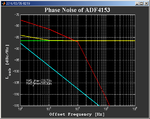exp
Full Member level 1
Trivial question: What is "Normalized Phase Noise" for PLLs?
For example, in https://www.ti.com/lsds/ti/clock-and-timing/rf-plls-and-synthesizers-products.page , this number is in dBc/Hz and ranges between -226 and -231.
Even more confusing here: **broken link removed** where they write: "Normalized Phase Noise (dBc/rtHz) (dBc/Hz)". Wtf? Hz or rtHz? Makes a big difference ...
Usually phase noise is denoted in dBc/Hz at different offset frequencies. Does "Normalized Phase Noise" mean that the frequency domain shape is just normalized to one over the operation bandwidth? In other words, the integral over the actual phase noise curve equals the normalized phase noise times the bandwidth?
If this is the case, is there a direct way to deduce jitter from this number?
Using the relation SNR = 20*log(1/(2*pi*fc*sigma) and sigma = sqrt(10^(A/10))/2/pi/fc
I arrive at the nice equation:
PN = -SNR - 10log(2B)
(where A is just PN + 10*log(2B) with PN the normalized phase noise in dBc/Hz and 2B the operation bandwidth (factor of 2 because phase noise curve is double sided)
which tells me for example that if I want an SNR of 50dB (due to phase noise) and a bandwidth of 400 MHz I would need a PLL with -139 dBc/Hz?
But this does not match the available numbers (in the range of -230dBc)
For example, in https://www.ti.com/lsds/ti/clock-and-timing/rf-plls-and-synthesizers-products.page , this number is in dBc/Hz and ranges between -226 and -231.
Even more confusing here: **broken link removed** where they write: "Normalized Phase Noise (dBc/rtHz) (dBc/Hz)". Wtf? Hz or rtHz? Makes a big difference ...
Usually phase noise is denoted in dBc/Hz at different offset frequencies. Does "Normalized Phase Noise" mean that the frequency domain shape is just normalized to one over the operation bandwidth? In other words, the integral over the actual phase noise curve equals the normalized phase noise times the bandwidth?
If this is the case, is there a direct way to deduce jitter from this number?
Using the relation SNR = 20*log(1/(2*pi*fc*sigma) and sigma = sqrt(10^(A/10))/2/pi/fc
I arrive at the nice equation:
PN = -SNR - 10log(2B)
(where A is just PN + 10*log(2B) with PN the normalized phase noise in dBc/Hz and 2B the operation bandwidth (factor of 2 because phase noise curve is double sided)
which tells me for example that if I want an SNR of 50dB (due to phase noise) and a bandwidth of 400 MHz I would need a PLL with -139 dBc/Hz?
But this does not match the available numbers (in the range of -230dBc)

